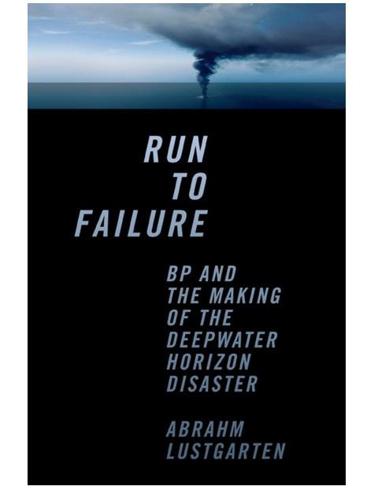Peter
Book Review: Run To Failure - BP And The Making Of The Deepwater Horizon Disaster

Here's the opening paragraph of Abrahm Lustgarten's book Run To Failure--BP And The Making Of The Deepwater Horizon Disaster
The burst of gas came from so deep within the bowels of the earth it may as well have come from another world. Thirteen thousand feet beneath the ocean's silty floor and the earth's crust and another five thousand feet underwater-a total depth farther than fourteen Empire State buildings stacked atop one another-hydrocarbons in the form of hot fluid saturated with dissolved methane seeped through the reinforced walls of a new oil well. The well, an exploratory venture drilled by BP and called Macondo, was a three-mile-long tube of cement and steel that had been burrowed into the million-and-a-half-year- old rock in the weeks before. It was one of the industry's most important new efforts to find oil in the deep waters off the southern coast of the United States, and, while not the deepest, the Macondo was pushing the limits of drilling.The book is written in a typically modern cinematographic style with fast forwards and flashbacks, and is focused on a small number of key characters, which gives it the feel of a novel, and reminds me stylistically of Peter Benchley's popular classic Jaws. For example we are introduced to a government lawyer like this:
Jeanne Pascal turned on her TV on April 21, 2010, just a few hours after the blast, to see a spindle of black smoke slithering into the sky from an oil platform on the oceanic expanse of the Gulf of Mexico. Right away she thought that it was a BP disaster unfolding on the screen. For a long while she sat transfixed on an overstuffed couch in her Seattle-area home, her feelings shifting from shock to anger. God, they just don't learn, she thought.This is an excellent book that anyone who is interested in investing in oil stocks ought to read, if only for the detailed background and history of the oil exploration industry that it brings to the table, an appreciation of the risks of oil exploration and production, and a partial explanation for the volatility of energy stocks.
The author's main thesis is that BP (BP), historically has been accident prone because of a tendency to push for higher profits by cutting costs on the ground, which means reducing maintenance, cutting redundancies out of staff schedules, etc.
At the same time CEO's like John Browne and Tony Hayward constantly announced new initiatives to improve safety. The problem was that while they reduced minor accidents by encouraging employees to use handrails or shoes studs in icy weather, or seat belts in vehicles, that didn't prevent massive disasters like the Texas City oil refinery and later the Deepwater Horizon.
Part of the problem may have been a cultural conflict between the British top management and the US work force inherited from Amoco when the two companies merged. Typically US workers like to have a high level of supervision and to be told what to do with strict checks in place, whereas British companies prefer a less regimented approach that put more trust in qualified employees to use common sense and do the right thing according to the situation.
This example exemplifies the dilemma:
When Tony Hayward took the helm at BP, he swore that everything would change. BP would be a new company, stripped of all that had led it down the perilous path of the past few years but still strong and profitable and growing. He was inclined to believe that the past was in the past, and in 2007, he was charting his own ambitious path for the company into the future.And so we learn that at the time of the Texas oil refinery disaster the site supervisor on duty on the day shift was working his thirtieth 12-hour shift in succession and that when he was called away on an emergency with a sick family member, the lack of redundancy in the schedules meant that there was no one of equivalent status left behind to oversee the reactivation of a raffinate splitting tower and that an inexperienced control board operator was left in charge during a period in which the tower which was supposed to be filled with highly flammable fuel to a depth of 8 feet was filled to 140 feet without anyone catching on that something was wrong.
For all of John Browne's remarkable successes in the twelve years he had run the "assurance." These are the layers of checks, balances, and systems meant to ensure that decisions aren't made hastily; that workers' concerns are communicated to management; and that regulations guaranteeing safety aren't abused for the sake of expediency.
In (Hayward's) view there were too many protective layers. Forethought and safety had become bureaucracy, and excessive cautiousness was paralyzing. For Hayward, assurance equaled waste.
"Assurance is killing BP today," Hayward told the town hall gathering in Houston the same day he shocked the markets by characterizing his own company's performance as "dreadful." "Right now we have multiple layers of assurance, too many layers. I don't think that having all these layers of assurance reduces risk, and it can actually increase it. The best way to reduce risk is to have deep technical competence where we need it. Individuals need to be accountable for risk, and to manage it."
This unfortunately exploded and led to the incineration and death of contract workers in trailers that were situated much too close for safety to the raffinate splitter tower. Ironically the trailers that burned were decorated with banners celebrating the safety record of the contractor.
The book, however contains much more than a detailed social history of some disasters, and gives the reader a great deal of background information about the global oil industry, the Alaska North Slope, The Exxon Valdez disaster, the Trans-Alaska pipeline system, the Gulf of Mexico, and the geopolitics of the energy business, all parceled in a very easy-to-read package.
You will no doubt come away wondering about the wisdom of rewarding senior executives with large bonuses linked to the price of a company's stock, when boosting the share price might come at the cost of risking the lives of employees and making children into orphans. Whatever happened to the idea of a fair day's pay for a fair day's work?
You may also wonder about the wisdom of management by statistics, when accident can be reduced numerically by using enforcing hand rail and seat belt usage, while losing sight of the much greater risks of dealing with the forces of nature.
Steven Spielberg who directed the movie version of "Jaws" had the best take on the original book version of "Jaws" when he said that the characters in it are so unlikable he pulled for the shark.
If you enjoyed Jaws, you will probably enjoy this book too, and if you can read between the lines of some of the more sensational parts, you can come away with a deeper understand of the oil industry and the safety, environmental, and political issues that have plagued the oil business.
Disclosure: I am long BP.




No comments:
Post a Comment